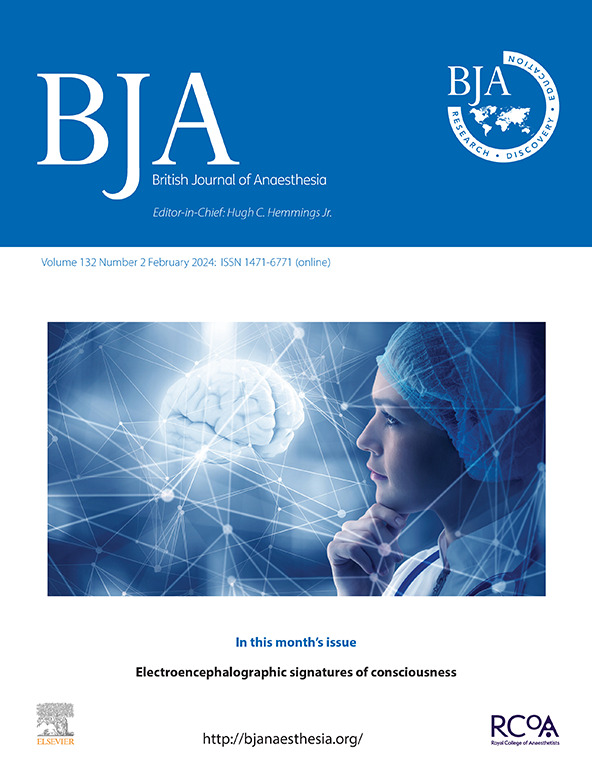Pharmacokinetic modelling and simulation for prolonged infusion of levobupivacaine with or without epinephrine in transversus abdominis plane and erector spinae plane blocks: a randomised controlled trial and analysis of pooled data.
IF 9.1
1区 医学
Q1 ANESTHESIOLOGY
引用次数: 0
Abstract
BACKGROUND Interfacial blocks often require large volumes of local anaesthetic, raising concerns about systemic absorption and potential toxicity. This study examined the pharmacokinetics of levobupivacaine with and without epinephrine during thoracic erector spinae plane (ESP) or transversus abdominis plane (TAP) blocks, simulating reported 48-h dosing regimens to evaluate safety. METHODS Data from three studies were analysed. Study 1 included 38 patients receiving an ESP block before video-assisted thoracoscopy, whereas Study 2 analysed published data on TAP blocks. Both studies used 20 ml of levobupivacaine 0.25% with or without epinephrine (5 μg ml-1), measuring arterial concentrations over 90 min. Study 3 involved intravenous bupivacaine administration in 10 healthy volunteers. Pharmacokinetic analysis used NONMEM software, with significance set at P<0.05. RESULTS We analysed 258 ESP samples, 150 TAP samples, and 190 bupivacaine i.v. SAMPLES A one-compartment model described the data, with a mean distribution volume of 41.9 L (coefficient of variation, 47%) and clearance rate of 0.288 L min-1 (coefficient of variation, 38%). Epinephrine reduced bioavailability (54.3% vs 32.8%) and prolonged absorption half-life (0.84 min vs 1.55 min; P<0.05). Simulated doses of 50 mg plus 300 mg per 24 h over 48 h remained below toxic thresholds. CONCLUSIONS Similar dosing regimens for ESP and TAP blocks are supported by this pharmacokinetic analysis, with epinephrine effectively reducing systemic drug concentrations by prolonging absorption half-life and lowering bioavailability. The findings suggest that extended 300 mg per 24 h dosing for 48 h is likely to be safe. Further studies in broader patient populations are warranted to evaluate safety. CLINICAL TRIAL REGISTRATION NCT04799184.左布比卡因加或不加肾上腺素在腹横面和竖脊面阻滞中长时间输注的药代动力学建模和模拟:一项随机对照试验和汇总数据分析。
背景:界面阻滞通常需要大剂量的局部麻醉,这引起了对全身吸收和潜在毒性的担忧。本研究通过模拟已有报道的48小时给药方案来评估安全性,研究了左旋布比卡因加肾上腺素和不加肾上腺素在胸直肌脊柱平面(ESP)或腹横平面(TAP)阻滞期间的药代动力学。方法对3项研究的数据进行分析。研究1包括38名在电视胸腔镜检查前接受ESP阻滞的患者,而研究2分析了已发表的TAP阻滞数据。两项研究均使用20 ml 0.25%的左旋布比卡因加或不加肾上腺素(5 μg ml-1),在90分钟内测量动脉浓度。研究3涉及10名健康志愿者静脉注射布比卡因。药代动力学分析采用NONMEM软件,差异有统计学意义,P<0.05。结果ESP样品258份,TAP样品150份,布比卡因190份。samplesa单室模型描述数据,平均分布体积为41.9 L(变异系数47%),清除率为0.288 L min-1(变异系数38%)。肾上腺素降低了生物利用度(54.3% vs 32.8%),延长了吸收半衰期(0.84 min vs 1.55 min;P < 0.05)。48小时内每24小时50毫克加300毫克的模拟剂量仍低于毒性阈值。结论肾上腺素通过延长吸收半衰期和降低生物利用度,有效降低全身药物浓度。研究结果表明,每24小时300毫克的剂量延长48小时可能是安全的。有必要在更广泛的患者群体中进行进一步的研究来评估安全性。临床试验注册号nct04799184。
本文章由计算机程序翻译,如有差异,请以英文原文为准。
求助全文
约1分钟内获得全文
求助全文
来源期刊
CiteScore
13.50
自引率
7.10%
发文量
488
审稿时长
27 days
期刊介绍:
The British Journal of Anaesthesia (BJA) is a prestigious publication that covers a wide range of topics in anaesthesia, critical care medicine, pain medicine, and perioperative medicine. It aims to disseminate high-impact original research, spanning fundamental, translational, and clinical sciences, as well as clinical practice, technology, education, and training. Additionally, the journal features review articles, notable case reports, correspondence, and special articles that appeal to a broader audience.
The BJA is proudly associated with The Royal College of Anaesthetists, The College of Anaesthesiologists of Ireland, and The Hong Kong College of Anaesthesiologists. This partnership provides members of these esteemed institutions with access to not only the BJA but also its sister publication, BJA Education. It is essential to note that both journals maintain their editorial independence.
Overall, the BJA offers a diverse and comprehensive platform for anaesthetists, critical care physicians, pain specialists, and perioperative medicine practitioners to contribute and stay updated with the latest advancements in their respective fields.

 求助内容:
求助内容: 应助结果提醒方式:
应助结果提醒方式:


